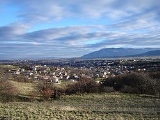
Bankya
Encyclopedia
Bankya is an upscale town and district in western Bulgaria
. It is administratively part of greater Sofia
.
The district is famous for the mineral spring
s and baths that have been used for their medicinal properties for hundreds of years. Prime Minister of Bulgaria Boyko Borisov
is a native. In 1969 the village of Bankya was proclaimed a town, and in 1979 it became part of Sofia, the capital of Bulgaria.
Bankya is 10 km west of the city of Sofia. It is situated at the foot of Lyulin
mountain at an average altitude of around 630–750 meters. The first people to populate the region of Bankya were Thracian
tribes, over 2500 years ago. Archaeological excavations near the quarter of Ivanyane have unearthed remains of Ancient Roman buildings, walls and sewers, and bronze bracelets from the 4th–5th century. Bankya's economy depends mainly on tourism and balneological treatment
.
Bankya was first mentioned as Bankya in the 15th century. The former villages of Verdikal, Gradoman and Mihaylovo are part of the town itself, while Ivanyane and Klisura are part of the municipality. Bankya's name stems from the common noun bankya, "hot spring", a diminutive of banya ("baths").
Bulgaria
Bulgaria , officially the Republic of Bulgaria , is a parliamentary democracy within a unitary constitutional republic in Southeast Europe. The country borders Romania to the north, Serbia and Macedonia to the west, Greece and Turkey to the south, as well as the Black Sea to the east...
. It is administratively part of greater Sofia
Sofia
Sofia is the capital and largest city of Bulgaria and the 12th largest city in the European Union with a population of 1.27 million people. It is located in western Bulgaria, at the foot of Mount Vitosha and approximately at the centre of the Balkan Peninsula.Prehistoric settlements were excavated...
.
The district is famous for the mineral spring
Mineral spring
Mineral springs are naturally occurring springs that produce water containing minerals, or other dissolved substances, that alter its taste or give it a purported therapeutic value...
s and baths that have been used for their medicinal properties for hundreds of years. Prime Minister of Bulgaria Boyko Borisov
Boyko Borisov
Boyko Metodiev Borisov is a Bulgarian politician who has been Prime Minister of Bulgaria since July 2009. Previously he was Mayor of Sofia from 8 November 2005 until his election as Prime Minister....
is a native. In 1969 the village of Bankya was proclaimed a town, and in 1979 it became part of Sofia, the capital of Bulgaria.
Bankya is 10 km west of the city of Sofia. It is situated at the foot of Lyulin
Lyulin
Lyulin may refer to:* Lyulin Mountain, in western Bulgaria, after which most others are named* Lyulin , municipality of Sofia* Lyulin Metro Station, a Sofia Metro station....
mountain at an average altitude of around 630–750 meters. The first people to populate the region of Bankya were Thracian
Thracians
The ancient Thracians were a group of Indo-European tribes inhabiting areas including Thrace in Southeastern Europe. They spoke the Thracian language – a scarcely attested branch of the Indo-European language family...
tribes, over 2500 years ago. Archaeological excavations near the quarter of Ivanyane have unearthed remains of Ancient Roman buildings, walls and sewers, and bronze bracelets from the 4th–5th century. Bankya's economy depends mainly on tourism and balneological treatment
Balneotherapy
Balneotherapy is the treatment of disease by bathing, usually practiced at spas. While it is considered distinct from hydrotherapy, there are some overlaps in practice and in underlying principles. Balneotherapy may involve hot or cold water, massage through moving water, relaxation or stimulation...
.
Bankya was first mentioned as Bankya in the 15th century. The former villages of Verdikal, Gradoman and Mihaylovo are part of the town itself, while Ivanyane and Klisura are part of the municipality. Bankya's name stems from the common noun bankya, "hot spring", a diminutive of banya ("baths").
Places of interest
- "Vazov's Oak", Ivan VazovIvan VazovIvan Minchov Vazov was a Bulgarian poet, novelist and playwright, often referred to as "the Patriarch of Bulgarian literature". He was born in Sopot, a town in the Rose Valley of Bulgaria ....
's favourite resting place. - Church of Martyrs Quiricus and Julietta, built in 1932 and inaugurated by bishop Stephen from Sofia.
- The former presidential residence which was later turned into a country golfGolfGolf is a precision club and ball sport, in which competing players use many types of clubs to hit balls into a series of holes on a golf course using the fewest number of strokes....
club. - Bankya Palace, a spa hotel.
- Mineral Baths in Bankya, built in 1907–1910 to the design of MunichMunichMunich The city's motto is "" . Before 2006, it was "Weltstadt mit Herz" . Its native name, , is derived from the Old High German Munichen, meaning "by the monks' place". The city's name derives from the monks of the Benedictine order who founded the city; hence the monk depicted on the city's coat...
architect Carl Hocheder

